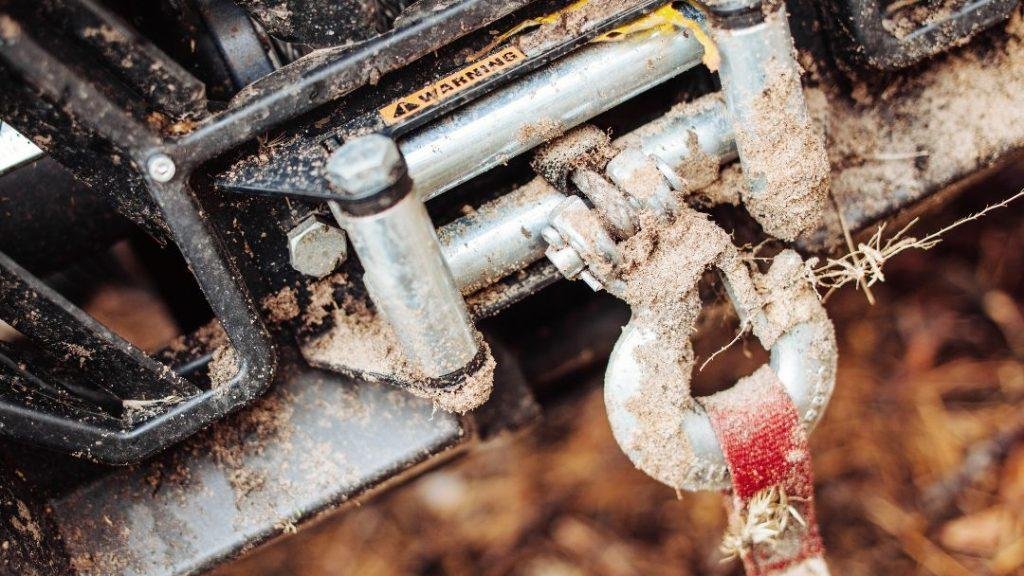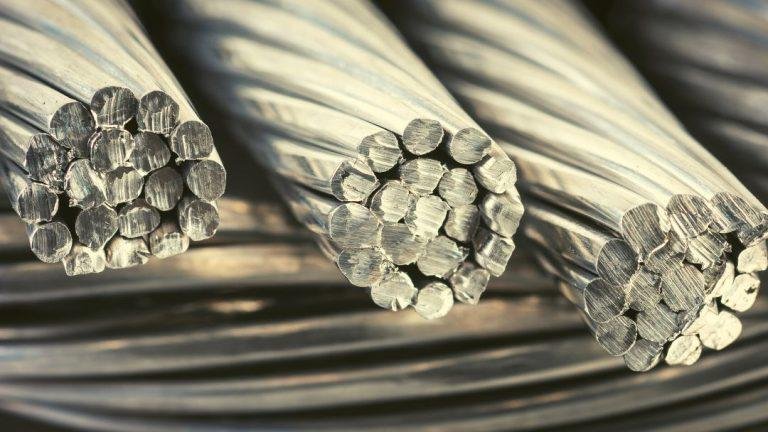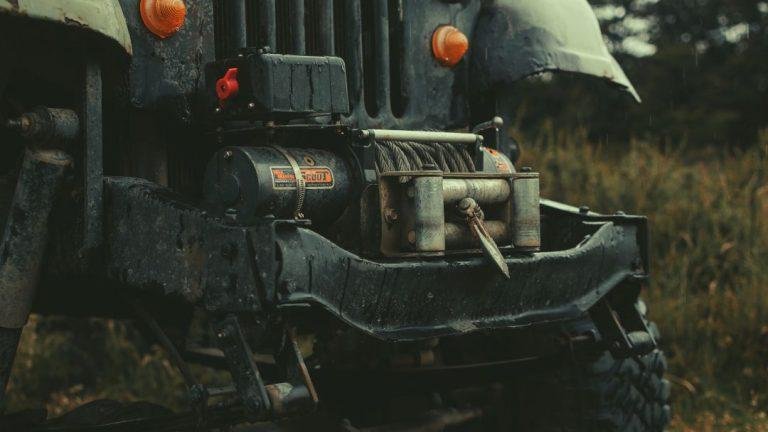Your ATV winch may have stopped working due to a faulty battery or a wiring issue. Here’s what you need to know to troubleshoot and fix the problem.
Introducing an answer to why your ATV winch has stopped working. There are several potential factors that can cause your winch to malfunction, including issues with the battery or wiring. Understanding the root cause of the problem is essential for troubleshooting and resolving the issue.
We will explore common reasons why an ATV winch may quit working and provide step-by-step guidance on how to diagnose and fix the problem. By following these troubleshooting tips, you can get your winch back up and running in no time, ensuring it is ready for your next off-road adventure.
Understanding The Basics Of Atv Winches
Understanding the basics of ATV winches is crucial, especially if your ATV winch quit working. Learn about troubleshooting tips and common issues to get your winch back in working condition. Discover how to identify problems and find solutions to ensure your ATV winch is always ready for action.
If you’re an ATV enthusiast, you understand the importance of having a reliable winch. A winch can save the day when you find yourself stuck in a tricky situation. But what happens when your ATV winch suddenly stops working? Understanding the basics of ATV winches can help you troubleshoot the issue and ensure that you’re prepared for any off-road challenge.
How Atv Winches Work
Atv winches are powered by an electric motor that drives a spool to wind and unwind the winch cable. When you activate the winch, the motor begins to turn, creating mechanical energy. This energy is then converted into pulling force, allowing the winch to drag your ATV out of tough spots.
Here’s a breakdown of how an ATV winch works:
- Electric motor: The heart of the winch, the electric motor provides the power needed to operate the winch.
- Gear train: The motor’s energy is transferred to a gear train, which amplifies the pulling force.
- Clutch: The clutch enables you to engage or disengage the winch drum, allowing you to control when the cable is pulled in or let out.
- Drum: The cable is wound around the drum when you reel it in and unwound when you let it out.
- Cable or rope: The winch cable or rope is the lifeline that connects your ATV to a secure anchor point, allowing you to pull or be pulled.
Common Components Of An Atv Winch
To better understand why your ATV winch may have stopped working, let’s take a closer look at its common components:
- Solenoid: The solenoid is responsible for transferring electrical power to the winch motor. A faulty solenoid can result in a winch that refuses to operate.
- Control switch: The control switch is what you use to activate and control the winch. If the switch malfunctions, it can prevent the winch from working.
- Wiring: The winch is connected to your ATV through a series of wires. Damaged or loose wiring can lead to loss of power and a non-functional winch.
- Battery: The battery provides the necessary power to the winch. If your battery is weak or dead, the winch may not function properly.
- Winch drum: The winch drum houses the cable or rope and is responsible for winding and unwinding it. A damaged or misaligned drum can cause the winch to jam or operate poorly.
Importance Of Regular Maintenance
Regular maintenance is crucial to keep your ATV winch in optimal condition. By taking care of your winch, you can prevent unexpected malfunctions and ensure its longevity. Here are some key maintenance tasks to remember:
- Clean and lubricate: Regularly clean the winch and apply appropriate lubrication to the moving parts to prevent rust and ensure smooth operation.
- Inspect cables and connections: Check for any frayed or damaged winch cables, as well as loose connections. Replace or repair as necessary.
- Test the winch: Periodically test your winch to ensure it is working properly. This includes engaging and disengaging the winch, as well as pulling in and letting out the cable.
- Keep the battery charged: Always maintain a fully charged battery to ensure that the winch has sufficient power when needed.
Understanding the basics of ATV winches and performing regular maintenance will help you avoid frustrating situations when your winch quits working. By keeping these essential components in mind and following proper maintenance procedures, you can rely on your winch to get you out of any off-road predicament.

Signs Of A Faulty Atv Winch
An ATV winch that suddenly stops working could indicate a fault, such as a burnt-out motor or a broken solenoid. Other signs include a lack of response when operating the controls or the winch not being able to pull any weight.
Identifying Common Problems:
- Strange noises: If your ATV winch is making unusual sounds such as grinding, clicking, or screeching, it could indicate a problem with the motor or gears.
- No response when activating the winch: If pressing the winch button has no effect, it may indicate a faulty solenoid or a disconnected wire.
- Weak or no pulling power: If your winch is struggling to pull or unable to pull at all, it could be due to a worn-out motor, worn winch cable, or a problem with the gears.
Steps To Take When The Winch Stops Working:
- Check the power supply: Ensure that the winch is receiving power by inspecting the battery connections and checking the fuse. Replace any blown fuse and fix loose connections.
- Inspect the control switch: Check the winch control switch for any visible damage or loose wires. If necessary, clean or replace the switch.
- Examine the winch cable or rope: Inspect the winch cable or rope for any signs of fraying, damage, or tangles. Replace if necessary, as a damaged cable can affect the winch’s performance.
- Verify the solenoid connections: Examine the solenoid connections for any loose or disconnected wires. Reconnect or tighten the wires if needed.
- Test the battery: If the winch is not working, it could be due to a weak or dead battery. Test the battery’s voltage using a multimeter and replace it if necessary.
Importance Of Troubleshooting Before Seeking Professional Help:
- Cost-effective solution: Troubleshooting the ATV winch before seeking professional help can save you money as you may be able to resolve minor issues on your own.
- Time-saving: By attempting to troubleshoot the winch yourself, you may be able to identify and fix the problem faster than waiting for a professional to arrive.
- Enhances your DIY skills: Troubleshooting and fixing your ATV winch allows you to develop your DIY skills and gain a better understanding of your vehicle’s mechanics.
- Peace of mind: Successfully troubleshooting and fixing your winch can give you a sense of satisfaction and peace of mind, knowing that you can handle minor issues independently.
Remember, by identifying common problems, following the necessary steps to resolve them, and troubleshooting before seeking professional help, you can get your ATV winch back in working order quickly and effectively.
Troubleshooting Tips For Atv Winches
Have trouble with your ATV winch that suddenly stopped working? Don’t worry! Here are some helpful troubleshooting tips to get your ATV winch back in action quickly and efficiently.
If your ATV winch has suddenly quit working and you’re left scratching your head, don’t worry! We’ve got you covered with some troubleshooting tips to help you identify and fix the issue. Follow these steps to get your ATV winch back in working order:
Checking The Power Source
- Ensure that your ATV’s battery is fully charged. A low battery can significantly affect the performance of your winch. If needed, recharge or replace the battery.
- Check the winch’s power cables. Make sure they are securely connected to the battery terminals, free from corrosion, and undamaged. Clean any corrosion using a wire brush if necessary.
- Inspect the fuse or circuit breaker in the winch’s power circuit. A blown fuse or a tripped circuit breaker can cause the winch to stop working. Replace the fuse or reset the circuit breaker as needed.
Examining The Wiring Connections
- Review the winch’s wiring connections. Ensure that all wiring is properly connected and not loose. Look for any visible signs of damage or wear, such as frayed wires or loose connectors. Repair or replace the wiring as necessary.
- Inspect the winch’s solenoid connections. Verify that the connections are tight and free from any corrosion or dirt buildup. Clean the connections with a suitable electrical cleaner if needed.
Testing The Control Switch
- Test the control switch to ensure it is functioning properly. If the winch does not respond when you engage the switch, it could indicate a faulty switch. Replace the switch if necessary.
- Check the control switch wiring for any loose connections or damage. Repair any issues found, making sure the wiring is securely connected.
Inspecting The Motor And Gears
- Examine the winch motor for any visible damage or signs of overheating. Look for loose, broken, or burned-out components. Replace any faulty parts as required.
- Check the winch gears for wear or damage. If the gears appear worn or stripped, they may need to be replaced. Ensure that the gears are properly lubricated.
Remember, troubleshooting your ATV winch may require some trial and error. If you’re unable to identify or fix the issue on your own, it may be best to consult a professional or the winch manufacturer for further assistance. By following these troubleshooting tips, you’ll be well on your way to getting your ATV winch working again and ready for your next off-road adventure.
Solutions To Common Atv Winch Issues
Having trouble with your ATV winch? Find effective solutions to common issues that can cause your winch to quit working. Discover troubleshooting tips to get your winch back up and running smoothly.
If you’ve found yourself in a situation where your ATV winch has suddenly quit working, don’t despair! Before rushing to the nearest repair shop, you might be able to tackle the issue yourself with a few simple steps. Here are some solutions to common ATV winch problems that can help you get back on track:
Replacing A Blown Fuse:
- Check the winch’s control box for a blown fuse.
- If the fuse is blown, carefully replace it with a new one of the same rating.
- Ensure that the new fuse fits securely and is properly seated.
Repairing Damaged Wiring:
- Inspect the wiring for any signs of damage or fraying.
- If any wires are found to be damaged, they will need to be repaired or replaced.
- Strip the damaged section of the wire, connect the new section, and insulate with electrical tape.
- Make sure all connections are secure and free from corrosion.
Cleaning And Lubricating The Winch:
- Over time, dirt, grime, and debris can accumulate in the winch, causing it to malfunction.
- Clean the winch using a gentle brush, mild soap, and water.
- Rinse thoroughly and allow it to dry completely before reassembly.
- Apply a suitable lubricant to the winch components to ensure smooth operation.
Replacing Worn-Out Components:
- Inspect the winch components for signs of wear and tear, such as frayed cables or a worn-out solenoid.
- If any components are damaged or worn out, they will need to be replaced.
- Purchase compatible replacement parts from a reputable source.
- Follow the manufacturer’s instructions to install the new components correctly.
Remember, troubleshooting and fixing common ATV winch issues doesn’t have to be a daunting task. By following these simple solutions, you may be able to save both time and money by resolving the problem yourself.
Enhancing The Performance Of Your Atv Winch
Enhance the performance of your ATV winch by troubleshooting common issues like when it quits working. Learn how to diagnose and fix problems to ensure your ATV winch is always ready for action on the trails.
Upgrading The Power Source
- Upgrading the power source of your ATV winch can significantly enhance its performance and ensure reliable operation when you need it most.
- Here are a few options to consider:
- Opt for a higher-capacity battery: By upgrading to a higher-capacity battery, you can increase the amount of power available for your winch, allowing it to handle heavier loads without compromising performance.
- Install a dual-battery system: A dual-battery system can provide extra power to your ATV winch, especially during demanding situations. This setup ensures that your winch has a backup power source and reduces the risk of discharging the primary battery.
- Explore lithium-ion batteries: Lithium-ion batteries are known for their lightweight design and high energy density, making them an excellent choice for ATV winches. These batteries offer longer runtimes and faster recharging compared to traditional lead-acid batteries.
Adding A Wireless Remote Control
- By adding a wireless remote control to your ATV winch, you can operate it from a convenient distance, enhancing both safety and convenience.
- Here’s why a wireless remote control is a valuable addition:
- Easy operation: With a wireless remote control, you no longer need to be right next to your winch during operation. You can control it from a safe distance, away from potential hazards, and without the hassle of dealing with a wired remote.
- Enhanced safety: By operating your winch remotely, you reduce the risk of injury from cables or other moving parts. It also allows you to have a clear view of the entire operation, ensuring safer and more efficient use.
- Convenience in difficult terrain: When you’re stuck in mud, traversing steep slopes, or encountering other challenging terrains, using a wireless remote control can greatly simplify the winching process. You can maneuver around obstacles or monitor the situation without being tethered to the winch.
Installing An Accessory Kit For Additional Functionalities
- If you want to expand the capabilities of your ATV winch, consider installing an accessory kit that offers additional functionalities.
- Here’s how an accessory kit can enhance the performance of your ATV winch:
- Multiple attachments: An accessory kit often includes various attachments such as snatch blocks, tree straps, and d-rings. These attachments allow you to perform complex recovery operations, change the pulling direction, or secure your winch to different anchor points, increasing the versatility of your winch.
- Synthetic rope upgrade: Many accessory kits offer synthetic ropes as an alternative to steel cables. Synthetic ropes are lightweight, easier to handle, and less prone to dangerous recoil if they break. They also provide greater flexibility and increased strength compared to traditional steel cables.
- Mounting options: Some accessory kits provide alternative mounting options for your winch, allowing you to adapt it to different ATV models or locations on your vehicle. This flexibility can optimize the performance and efficiency of your winch setup.
Remember, enhancing the performance of your ATV winch through power source upgrades, wireless remote controls, and accessory kits can make a significant difference in crucial situations. Choose the options that best fit your needs and maximize the effectiveness of your ATV winch.
Preventive Maintenance For Atv Winches
Regular preventive maintenance is crucial for keeping your ATV winch in working condition and preventing it from quitting unexpectedly. By following a maintenance schedule, checking for wear and tear, and ensuring proper lubrication, you can extend the lifespan of your ATV winch and avoid inconvenient breakdowns.
Regularly cleaning and inspecting the winch:
- Remove any dirt, debris, or mud build-up from the winch to ensure smooth operation.
- Inspect the winch components for any signs of damage or wear, such as frayed wires or loose connections.
- Check the control switch and wiring for any signs of corrosion or damage.
Lubricating moving parts:
- Apply grease or oil to the winch’s moving parts, such as the gears and bearings, to reduce friction and extend their lifespan.
- Make sure to use a lubricant recommended by the manufacturer to avoid damaging the winch.
Checking the integrity of the synthetic rope or cable:
- Inspect the synthetic rope or cable for any signs of fraying, kinks, or damage.
- Ensure that it is properly spooled onto the winch drum and there are no tangles or knots.
- If any issues are found, promptly replace the rope or cable to maintain the winch’s functionality and safety.
Maintaining proper tension on the winch drum:
- Check the tension of the synthetic rope or cable on the winch drum.
- Ensure it is neither too loose nor too tight, as improper tension can lead to premature wear or failure.
- Consult the winch’s manual for the recommended tension and make adjustments accordingly.
By following these simple preventive maintenance steps, you can ensure the longevity and reliability of your ATV winch. Regular cleaning, lubricating moving parts, checking the rope’s integrity, and maintaining proper tension on the winch drum will keep your winch in optimal working condition.
Remember, a well-maintained winch is essential for a hassle-free off-roading experience.
When To Seek Professional Help
Having issues with your ATV winch? If it suddenly stops working, it may be time to seek professional help for repairs. Don’t wait, get your winch back in working order with expert assistance.
Knowing When Diy Troubleshooting Is Not Enough
- If you’ve tried troubleshooting your ATV winch and it’s still not working, it may be time to seek professional help. Here are some signs that indicate DIY troubleshooting is not enough:
- The winch motor is not responding to any commands.
- The winch is making strange noises or emitting a burning smell.
- The winch cable is jammed or stuck.
- The winch battery is draining rapidly or not holding a charge.
- The winch remote control is not functioning properly.
Choosing A Reputable Atv Winch Repair Service
- When it comes to choosing a reputable ATV winch repair service, there are a few factors to consider. Here’s what you should keep in mind:
- Look for a repair service that specializes in ATV winches.
- Check for reviews and testimonials from previous customers.
- Inquire about the repair service’s experience and expertise in handling ATV winches.
- Ask about the turnaround time for repairs and if they offer any warranties on their services.
- Consider the location of the repair service for convenience and accessibility.
Considerations For Warranty Coverage
- Before seeking professional help for your ATV winch, it’s important to consider the warranty coverage. Here are some considerations to keep in mind:
- Review the terms and conditions of your winch’s warranty.
- Check if the warranty is still valid and if it covers the specific issue you’re experiencing.
- Determine if any repairs or seeking professional help will void the warranty.
- Contact the manufacturer or the warranty provider for guidance on the best course of action.
- Keep documentation of any repairs or communications related to the warranty for future reference.
Remember, although DIY troubleshooting can be cost-effective and satisfying, there are instances when professional help is necessary. By knowing the signs, choosing a reputable repair service, and understanding your warranty coverage, you can make informed decisions about when to seek professional assistance for your ATV winch.
Frequently Asked Questions On Atv Winch Quit Working
Why won’t My Winch Engage?
If your winch won’t engage, there are a few common reasons. First, check the power connection and ensure it’s properly connected. Next, inspect the winch motor for any signs of damage or worn-out parts. If everything seems fine, check the control switch to ensure it’s functioning correctly.
Sometimes, a faulty switch can prevent the winch from engaging. Additionally, inspect the winch solenoids for any signs of damage or loose connections. If any issues are found, they should be promptly fixed or replaced. Finally, double-check the winch’s wire rope tension and make sure it’s properly aligned on the drum.
Remember to maintain regular maintenance of your winch to prevent future engagement issues.
How Do I Know If My Winch Motor Is Bad?
To determine if your winch motor is bad, pay attention to the following signs: 1. Check the power source: and ensure the battery is fully charged and in good condition. If the winch doesn’t receive sufficient power, the motor could be affected.
2. Inspect the motor connections: examine the wiring connections for any loose or damaged parts. Faulty connections can lead to motor failure. 3. Listen for unusual sounds: If the motor emits strange noises like grinding or screeching, it may indicate internal damage.
4. Test the motor’s response: engage the winch and observe how the motor performs. If it struggles to operate or stalls frequently, there could be an issue. 5. Conduct a visual inspection: Look for any visual signs of damage or wear on the motor itself, such as burned-out wiring or melted components.
If you experience any of these issues, it’s likely that your winch motor needs to be replaced or repaired.
Can Atv Winch Solenoid Get Wet?
Yes, an ATV winch solenoid can get wet. Exposing the solenoid to water can cause damage and affect its performance. Water can enter the solenoid and cause corrosion, short circuits, and other electrical problems. It is important to keep the solenoid dry to ensure its proper functioning and longevity.
Using a waterproof cover or housing can help protect the solenoid from moisture. Regular maintenance and inspection of the solenoid can also help ensure that it remains in good working condition. If the solenoid does get wet, it is recommended to dry it thoroughly before using the ATV winch to prevent any potential issues.
How Do You Test A Winch Solenoid?
To test a winch solenoid, follow these steps: 1. Disconnect the power supply and remove the solenoid cover. 2. Inspect the wiring connections for any signs of damage or loose connections. 3. Use a multimeter to check the solenoid’s resistance. It should typically read between 20-30 ohms.
4. Test the solenoid’s coil by connecting the multimeter’s leads to the terminals. Apply power to the solenoid, and the meter should read a low resistance level. 5. Check the solenoid’s operation by connecting the multimeter’s leads to the control circuit terminals.
Apply power and verify that the solenoid clicks or engages. 6. Reassemble the solenoid and reconnect the power supply to ensure it functions properly. By following these steps, you can effectively test a winch solenoid and ensure its proper functioning.
Conclusion
Troubleshooting and resolving issues with your ATV winch can be a frustrating process, but it is essential to ensure its proper functioning. By following the steps outlined in this blog post, you can diagnose and fix common problems that may cause your ATV winch to quit working.
Regular maintenance and periodic inspections will also help avoid future issues and extend the lifespan of your winch. Remember to check the power source, connections, controls, and mechanical components to identify any potential faults. If you are unable to resolve the problem on your own, don’t hesitate to seek professional assistance.
Keeping your ATV winch in good working condition will provide you with peace of mind and ensure its reliability during critical situations. So, get your winch back up and running, and hit the trails with confidence!






